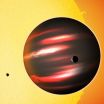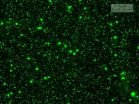(Press-News.org) BLOOMINGTON, Ind. -- A visiting researcher from Sweden in the Indiana University College of Arts and Sciences' Biology Department has led an international team in culturing, characterizing and formally naming a new class of fungi that previously had only been identified through DNA sequencing from environmental samples.
Structures on Roots
The new fungal class Archaeorhizomyces, previously known as Soil Clone Group 1 (SCG1), has now been found in more than 50 ecological studies of soil fungi. Prior to the work reported by the team led by Swedish biologist Anna Rosling, who currently works in the IU Bloomington biology laboratory of Rich Phillips as an associate researcher, the organisms had never been observed in the form of a fruiting body, spore, culture or in any distinctive association in a relationship with a plant. The report, which appears in the Aug. 12 edition of Science, estimates as many as 250 species in the description of the new class.
"Scientists believe that only one-tenth of fungal diversity has been described, and of the fungal lineages known only through environmental DNA sequences, this one -- Soil Clone Group 1 -- was the most common," Rosling said. "And while we still do not know this group's precise ecological niches and the complete life cycle, isolating and describing cultures of this group will allow their role in terrestrial ecosystems to be deciphered, and in turn contribute toward cataloguing and understanding the missing diversity of the fungal kingdom."
First found in tundra soil fungal communities only in summer, Archaeorhizomyces species are now considered globally distributed and with specific ecosystem and habitat associations among some species. The three most sampled species colonized typical ectomycorrhizal habitats, with fungi forming symbiotic relationships with plants by forming a sheath around the root tip of the plant, in this case with roots of pine trees and understory plants preferring acidic soil.
But Rosling said there still is no evidence that Archaeorhizomycetes form mycorrhizal structures in pine roots, and instead may coexist with other fungi in single root tips, showing no preferential growth toward main, primary or secondary roots, and not altering root tip morphology.
Prior to the work researchers were unsure of Archaeorhizomyces' role in the ecosystem, and had theorized that the fungi were mycorrhizal, or obligately associated with the roots of plants, getting carbon from those plants. The new findings provide evidence that Archaeorhizomyces is not mycorrhizal and their apparent association with roots of plants is possibly though association with mycorrhizal fungi.
"Our feeling now is that plant host and habitat specificity for different species of Archaeorhizomycetes may not necessarily be explained by specificity towards the plant, but may instead reflect an association with other root-associated fungi," she said. "When we inoculated onto sterile pine seedlings, the mycelium of one Archaeorhizomycetes, A. finlayi, associated with roots, but no mycorrhizal structures are observed. Yet the inoculated seedlings remained healthy for months with no signs of fungal pathogenicity."
Archaeorhizomycetes is phylogenetically placed within the subphylum Taphrinomycotina in the Ascomycota phylum. Commonly known as sac fungi, Ascomycota is the largest phylum in the fungi kingdom, comprising about 75 percent of all fungi, or more than 64,000 species. Species in the new class are filamentous and threadlike, and because they lack macroscopic features they can not be identified without DNA testing. And while not recognized as forming mycorrhizal structures, they potentially receive nutrition from dead and decaying plant material, the paper reported.
With the new class now properly sequenced, researchers have not only recognized that its abundance had previously been underestimated, but that they have set themselves on a course to better define Archaeorhizomycetes' role in ecosystems and toward identifying more species and populations within the class.
INFORMATION:
Contributors on the paper with Rosling were Karelyn Cruz-Martinez, Katarina Ihrmark, Björn D. Lindahl and Audrius Menkis, all researchers with Rosling at the Department of Forest Mycology and Pathology, Uppsala BioCentre, SLU, Sweden; Filipa Cox, Imperial College London and Royal Botanic Gardens, Kew, London, UK; Gwen-Aëlle Grelet of The University of Aberdeen and James Hutton Institute, Aberdeen, UK; and Timothy Y. James, Department of Ecology and Evolutionary Biology, University of Michigan, Ann Arbor, Mich.
To speak with Rosling or for more information, please contact Steve Chaplin, University Communications, at 812-856-1896 or stjchap@iu.edu.
Visiting researcher at IU leads international team in formal identification of new fungi class
2011-08-12
ELSE PRESS RELEASES FROM THIS DATE:
Arctic ice melt could pause for several years, then resume again
2011-08-12
BOULDER—Although Arctic sea ice appears fated to melt as the climate continues to warm, the ice may temporarily stabilize or somewhat expand at times over the next few decades, new research indicates.
The computer modeling study, by scientists at the National Center for Atmospheric Research, reinforces previous findings by other research teams that the level of Arctic sea ice loss observed in recent decades cannot be explained by natural causes alone, and that the ice will eventually disappear during summer if climate change continues.
But in an unexpected new result, ...
New research explains how estrogen could help protect women from cardiovascular disease
2011-08-12
The sex hormone oestrogen could help protect women from cardiovascular disease by keeping the body's immune system in check, new research from Queen Mary, University of London has revealed.
The study has shown that the female sex hormone works on white blood cells to stop them from sticking to the insides of blood vessels, a process which can lead to dangerous blockages.
The results could help explain why cardiovascular disease rates tend to be higher in men and why they soar in women after the menopause.
The researchers compared white blood cells from men and pre-menopausal ...
Alien world is blacker than coal
2011-08-12
Astronomers have discovered the darkest known exoplanet - a distant, Jupiter-sized gas giant known as TrES-2b. Their measurements show that TrES-2b reflects less than one percent of the sunlight falling on it, making it blacker than coal or any planet or moon in our solar system.
"TrES-2b is considerably less reflective than black acrylic paint, so it's truly an alien world," said astronomer David Kipping of the Harvard-Smithsonian Center for Astrophysics (CfA), lead author on the paper reporting the research.
In our solar system, Jupiter is swathed in bright clouds ...
Coke addicts prefer money in hand to snowy future
2011-08-12
When a research team asked cocaine addicts to choose, hypothetically, between money now or cocaine of greater value later, "preference was almost exclusively for the money now," said Warren K., Bickel, professor in the Virginia Tech Carilion Research Institute, director of the Advanced Recovery Research Center, and professor of psychology in the College of Science at Virginia Tech. This result is significantly different from previous studies where a subject chooses between some money now or more money later.
Hollywood portrays cocaine addicts as people who will do anything ...
In quest for new therapies, clinician-scientist team unlocks hidden information in human genome
2011-08-12
The work of molecular biologist Joseph M. Miano, Ph.D., and clinician Craig Benson, M.D., seems worlds apart: Miano helps head the Aab Cardiovascular Research Institute and Benson is chief resident of the combined Internal Medicine and Pediatrics program at the University of Rochester Medical Center. Though the chance of their professional paths crossing was highly unlikely, shared enthusiasm, intense curiosity and a little detective work led to a unique collaboration and important new insights on the inner workings of the human genome.
Together, Miano and Benson created ...
Training to Improve Electrical Workers Safety, Confidence and Effectiveness
2011-08-12
Critical Information Network (CiNet), LLC, announces the release of its newly updated Electrical 1 training series designed to help companies improve the electrical maintenance practices of workers and meet the demands of today's busy training manager.
According to OSHA and the National Fire Protection Association (NFPA), electrical accidents and the resulting fires cause millions of dollars in damages, countless injuries and life threatening workplace events every year. The tragedy is that many of these could have been avoided by simple maintenance repairs supported ...
Stem cell mobilization therapy found to be safe for bone marrow donors
2011-08-12
(WASHINGTON, August 11, 2011) – According to a study published in Blood, the Journal of the American Society of Hematology (ASH), researchers have reported that administration of granulocyte colony-stimulating factor (G-CSF), a drug that releases stem cells from the bone marrow into the blood, is unlikely to put healthy stem cell donors at risk for later development of abnormalities involving loss or gains of chromosomes that have been linked to hematologic disorders such as myelodysplastic syndromes (MDS) and acute myeloid leukemia (AML).
G-CSF therapy is given to healthy ...
Heat Wave Sees Surge in Sweat Cure Enquiries
2011-08-12
While many Britons enjoyed the recent heatwave, taking the chance to lie back and top up their tans, for others it only served to heighten their fears of damp armpits and clammy hands.
As a result, Transform Cosmetic Surgery Group recorded a 45% surge in enquiries into use of BOTOX injections a treatment for excessive sweating over a three-day period of the heatwave as the nation become more perspiration-conscious.
Known as hyperhidrosis, the condition sees sweat glands become overactive, something often made worse during periods of hot weather. During the procedure, ...
New model of ALS is based on human cells from autopsied tissue
2011-08-12
By isolating cells from patients' spinal tissue within a few days after death, researchers funded by the National Institutes of Health have developed a new model of the paralyzing disease amyotrophic lateral sclerosis (ALS). They found that during the disease, cells called astrocytes become toxic to nerve cells – a result previously found in animal models but not in humans. The new model could be used to investigate many more questions about ALS, also known as Lou Gehrig's disease.
ALS can run in families, but in the majority of cases, it is sporadic, with no known ...
Decade-long study reveals recurring patterns of viruses in the open ocean
2011-08-12
(Santa Barbara, Calif.) –– Viruses fill the ocean and have a significant effect on ocean biology, specifically marine microbiology, according to a professor of biology at UC Santa Barbara and his collaborators.
Craig A. Carlson, professor with UCSB's Department of Ecology, Evolution, and Marine Biology, is the senior author of a study of marine viruses published this week by the International Society for Microbial Ecology Journal, of the Nature Publishing Group.
The new findings, resulting from a decade of research, reveal striking recurring patterns of marine virioplankton ...


